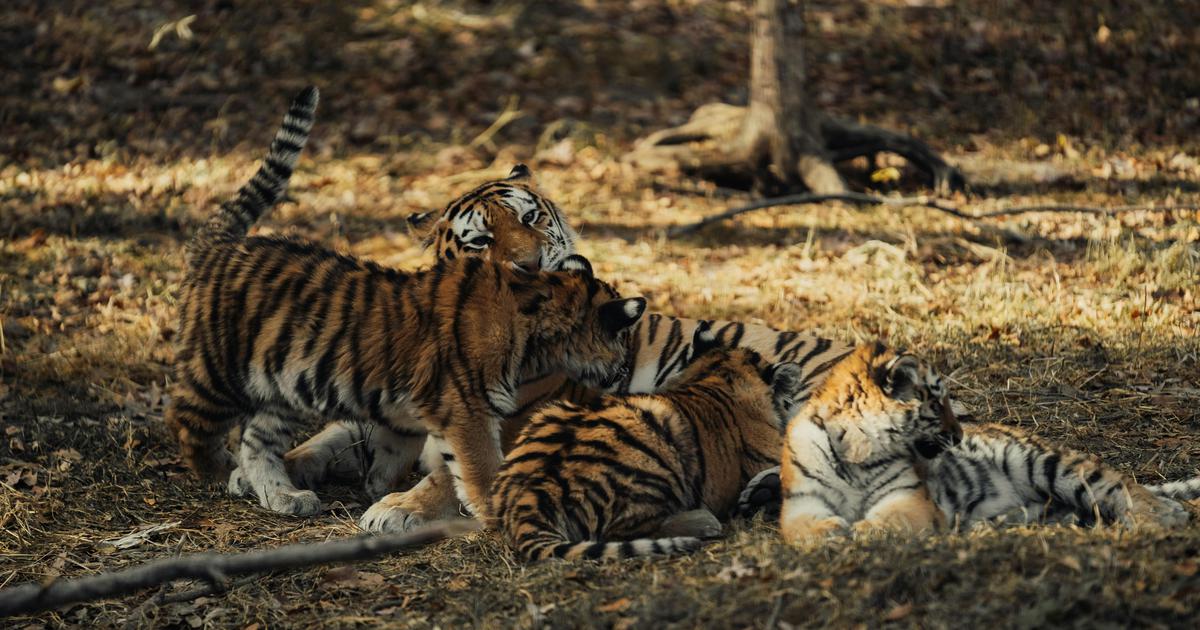One of the things I’d always wanted to see was a tigress with cubs aged between one and four months, so as to observe the bonding between mother and cubs. We had seen Noon’s cubs at five months but the earlier period was altogether invisible. Laxmi would grant us a peek into this stage of a tiger’s life. In the early 1980s, she had moved to a corner of her mother Padmini’s range between Lakarda and Bakaula, encompassing the valley of Semli. In the first part of the 1980s, she was evasive and elusive. I believe this was her basic nature as she had grown up in an environment that was heavily disturbed by humans.
However, early one morning in March 1986, when Laxmi was nearly ten years old, she gave me the privilege of observing her with her young cubs – an experience that would grant me more insight into the mysterious world of tigers. That day, as I turned a bend in the road, there facing me at the edge of the track was Laxmi. She sat very still, looking at me. At first, I did not see what was around her. Then I realised that three tiny cubs were peeping around a bush. I froze. Soon, she relaxed and all three cubs came out to cuddle her. She licked them vigorously. The cubs looked about two months old. It seemed that this was their first encounter with a jeep. As she licked her cubs, I realised that another aspect of the tiger’s secret life was unfolding before my very eyes. The cubs slowly found her teats and she lay back to suckle them. This was, for me, a first. Their tiny feet pushed away at her belly, stimulating the flow of milk, as they suckled furiously. After ten minutes, they jumped around her head and stalked a butterfly in the grass. One of them jumped on her back and another pulled at her tail while she licked the third cub. I watched this family drama for half an hour. Tears rolled down my cheeks as a tangle of emotions exploded within. I had seen all manner of tiger behaviour in the course of my life with the wild animal. I had seen the kills. I had seen how they ate. I had seen the aggression, the power, and the fierceness. Here I was witnessing the tender care, the devotion, and a mother’s love. Gentle and loving, the tigress soon rose and led her cubs away. For the next three months, it was their remarkable family life that completely captivated me. Laxmi was very much like Padmini in her basic temperament. Calm and mature-looking, I seldom saw her ruffled. She had a lovely deep colour to her coat, and a swagger as she walked the paths and roads. She never feared the resident male or even transients. She commanded respect. Nothing she did was reckless or risky – and underneath it all was the fact that she was an amazingly devoted mother.
The next morning I found Laxmi sitting in a grass patch 10 to 15 metres from the jeep track. Her three cubs surrounded her. One nuzzled her face, another rested against her back, the third watched us curiously. Very tentatively, one of the cubs moved a little towards us before rushing back to the security of its mother. Soon, the cubs turned to each other and began leaping into the air and knocking into each other. After every bout, they rushed to Laxmi, who licked and cuddled them and soon decided to lie on her side and suckle them. All three soon found a teat and began to feed. I watched this remarkable spectacle for more than fifteen minutes. I have never seen such a display of love and warmth, such evidence of the strong bonding between a tigress and her cubs.
Over the next few days, we encountered Laxmi’s family regularly in the valley of Semli and after each encounter, we were able to get closer and closer. Laxmi slowly got used to us. After that she was never bothered by our presence or our cameras clicking away. Slowly, the cubs got bolder and one of them – who was the most confident – even approached within one metre of our jeep. We soon realised that there were two females and one male cub.
One afternoon I found Laxmi just after she had killed a chital stag. She dragged it quickly up the rise of a hill and into thicker forest. Of the cubs there was no sign. In about ten minutes, she came out of the forest and walked 100 metres towards a network of ravines. I decided to follow, taking the jeep off-track and cross-country. Laxmi approached a bend in the ravine and called out ‘Aaooo’ several times. As she turned the bend, I drove to the edge of the hill to look down. Below us was a gorge 30 metres long and 10 metres wide, surrounded on two sides by a cliff and a rock overhang some 20 metres high. There were two caves in the cliff face and the three cubs came rushing out of one of them. Dense cover carpeted the floor of the gorge and a large pool of water reflected the light of the evening sun. It was a perfect hideout. Amidst a great deal of squeaking and squalling, the cubs greeted their mother with much nuzzling and slowly followed her out of the ravine, meowing plaintively, as if they knew they were being led to a feast. On reaching a clearing, Laxmi settled down to lick her cubs, showing once again the intimate bond they shared. They then strode off towards where the carcass had been left. I followed through bush and rock until I could go no further. As I watched through a pair of binoculars, I noticed that Laxmi had opened the rump of the spotted deer and the cubs were greedily devouring whatever they could. It was clear that the cubs were used to meat even before the age of three months. It is this diet of milk and meat that makes them grow so quickly. Adult tigers prefer to eat from the choicest portion of the carcass, which is the rump, and then slowly move towards the neck. Cubs, in their greed, attack whichever portion they get to first. While they eat they snarl, hiss, and try to growl. It is incredible, the variety that exists in the language of the tiger.
For the next few weeks, Fateh and I spent many days watching the cubs, observing and documenting facets of their lives and recording events that we had never seen before. It was April and the onset of summer. While waiting for Laxmi the cubs spent much of their time soaking in the water and fighting the heat. Cooling off in water is essential when summer temperatures cross 40 °C to 45 °C.
For Laxmi’s young family, a bit of playing, some climbing and exploring, and a lot of sleeping was their daily routine. Laxmi’s days were spent searching for prey. Choosing the right bush, she would appear to be asleep but at the slightest sound, she would be alert and ready to pounce on an unsuspecting deer. Several times we watched her bring portions of her kill to the cubs to feed on. Whenever this happened, the cubs would bound towards her in great excitement, each trying to be the first to reach the kill. The cubs were now becoming more adventurous, exploring the small ravine which was their den, nibbling at twigs and branches, chasing partridges and hares, chewing whatever came their way, prodding at stones and boulders, and investigating any small movement, be it of birds or even lizards. New sounds like the sudden booming alarm call of the sambar, which had frightened them earlier, would now be accepted and they would raise their heads to sniff the air. The raucous barking of a troop of langurs would keep them alert and motionless and the shrill call of the storkbilled kingfisher would arouse their curiosity. A whole new world of sight and sound was unfolding and these young ones were learning to interpret it. The remnants of bones around their den would attract a stream of king vultures and crows and their movement was carefully watched by the cubs. The vultures never tried to land as the gorge was too narrow for them to feel safe. Crows were chased away. The occasional mongoose that slipped into the ravine would quickly retreat because the smell of tigers was everywhere.

Excerpted with permission from The Mysterious World of Tigers: A Book of Discovery, Valmik Thapar, Aleph Book Company.










